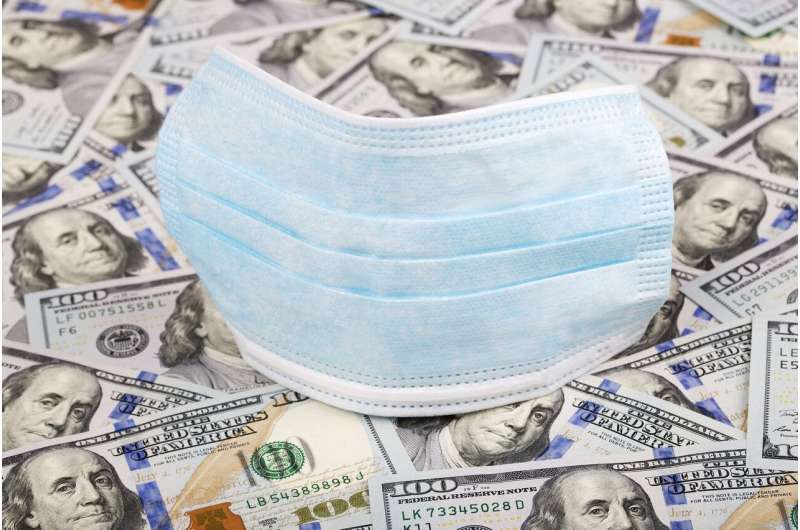COVID-19 further exposes inequalities in the global financial system

To stem the , developed countries have injected an unprecedented .
has recommended sustained fiscal support, emphasizing greater spending on .
Meanwhile, countries in the "global south"—broadly, low- and middle-income countries in Latin America, Asia and Africa—face . They don't have the ability to inject that level of cash into their economies.
And it's not only because their economies are poorer.
As an , I focus on the systemic that block such access in developing economies.
With a greater public awareness of soaring , it is also important to recognize the deep .
Inaccessible financing
Fiscal support in developed economies is often financed by deficit spending and government borrowing. Countries like the United States finance a major part of deficits by borrowing from companies and central banks within their own countries. Such borrowing remains in the countries' own currency, making them less risky.
The in advanced economies—a including the U.S., European countries and Japan—is projected to expand to 14.4% in 2020 from 3.3% in 2019, according to the IMF.
This deficit financing is practically inaccessible to developing economies, given the extreme inequalities in . These nations secure most of their deficit financing through lending from multilateral agencies like the International Monetary Fund. Or they borrow dollars in international capital markets. They then have to pay back the debt in dollars, which makes the loans more expensive if the value of their own currency drops.
Not all debt is equal
During the , the limited availability of multilateral lending forced low-income countries – – to fund recovery efforts and infrastructure expansion by borrowing dollars in private markets.
also relied on private loans to recover from the financial crisis and .
To reimburse these loans, low-income countries from the exportation of raw materials, or commodities, and tourism, which are paid in U.S. dollars.
Dependence on the sale of commodities, an outcome of trade patterns established by the European colonization of the global south in the 19th century, is often associated with .
The , for example, caused big declines in dollar earnings in the global south. It also led to a fall in the currency values of commodities exporters.
Consequently, interest payments and the value of dollar-denominated debt increased in countries like . The commodities crash also increased debt burdens in such countries as . Facing a sudden devaluation of their currencies and lower export earnings, many countries had to borrow more to continue to service previous loans.
Payments on external debt as a percentage of government revenues also ballooned.
Though low-income economies borrow less compared with their GDPs—an estimate of the value of the goods produced by their economies—payment burdens are greater because most payments are external and have to be made in dollars.
Ghana's debt-to-GDP ratio in 2018, for example, was compared with 90.5% for the United States. As a group, the debt-to-GDP ratio in low-income economies—usually defined as countries with per capita income of – averaged about 20%, . That compares with 105% in advanced economies. These numbers contradict the view that low-income countries tend to overborrow.
Yet because of exchange rate risks and dollar payments, Ghana's ratio of external payments to revenue, for example, rose from 10% in 2014 to in 2018.
These rising ratios also led to downgrades in credit ratings by private rating agencies and classifications of high risk status by the IMF's Debt Sustainability Framework.
for focusing on payment capacity and viewing all debt equally. They say that the IMF should distinguish between debt that is wasteful, such as recurring administrative expenses, and debt that funds crucial .
Meanwhile, ratings downgrades led to higher costs for the new loans, as lenders sought to mitigate greater perceived risk.
This, in turn, set off a new cycle of higher debt burdens.
Calls for debt relief
Amid COVID-19, key dollar-earning sectors in developing countries – – are projected to take deep hits. , a research forum of prominent economists, expects a decline for low-income countries.
This has set off another wave of credit rating downgrades that will make borrowing prohibitively expensive.
The African Peer Review Mechanism, a , recently these downgrades for blocking efforts to mobilize fiscal resources amid the pandemic.
In , for example, the credit rating downgrade may force the government to scrap plans to expand health care spending during the pandemic.
So while advanced countries on recovery efforts in 2020, low-income countries have managed an average of 1.4% of GDP. And only 0.6% of GDP has been spent in the health sector, according to the IMF.
Amid the pandemic, some and an expanded allocation of the IMF's global reserve currency unit, known as Special Drawing Rights.
Proposed expansions of Special Drawing Rights would be allocated to each member country of the IMF. That would allow increased and therefore reduce the need for dollar earnings.
I believe such measures are a necessary corrective to the disparate burdens and systemic inequalities in the global financial system.
Provided by The Conversation
This article is republished from under a Creative Commons license. Read the .![]()




















